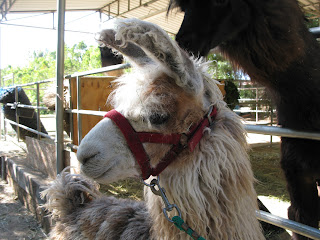LLAMA CAR WASH
October 8, 2011
HERE'S HOW TO WASH A LLAMA
IN ONLY THREE HOURS
STEP ONE: Find or make a Llama Car Wash, which looks like this:
 |
| Pajama Llama Stands in a Llama Car Wash |
STEP TWO: Wet the llama using an ordinary garden hose.
Pajama Llama volunteered to drench his own coat for this blog story.
Pajama Llama loves sprinklers! When this animal encounters water, he's interested! He likes to put both his feet in water buckets, stand in a child’s wading pool on hot days, and drink seven gallons of water each day during the summer months. But Pajama Llama and his pack members are not fond of soap on their coats! That’s because they know that llama wool becomes dried out if washed frequently with soap. You see, unlike sheep wool with its oily (and itchy) lanolin, llamas have little to no oils in their coats, which makes them hypoallergenic! It’s best to wash a llama two times a year maximum to keep the wool looking silky and the skin healthy. Of course there are expensive llama shampoos and cream rinses for more frequent shampoos. But if you wash a llama only twice a year, Tide Detergent works quite nicely. Truly!
STEP THREE: Soap up the llama. Mama Llama decided not to coax Pajama Llama back into the chute. Instead, she put Dalai Llama in and let the groomer work her magic on this white llama. Here's what a wet, sudsy llama looks like:
 |
| Dalai Llama Gets a Shampoo |
Which is more pathetic: a wet cat or a wet llama?
STEP FOUR: Remove the soap. With llamas, that’s not easy. Sudsy soaps are difficult to rinse out, but they do a fine job of cleaning dirty llama wool. Life’s a trade-off, isn’t it? The solution in this case is, of course, a drip hose! That is nothing more than a hose with holes in it every few inches. Just run this hose down the llama’s coat over and over…and over and over…and over and over again. You’ll get all the soap out in about...an hour. No kidding.
STEP FIVE: Dry the llama immediately, or he will roll his clean, wet coat in the dirt. How do you dry a llama? Easy. Use a leaf blower--those obnoxiously loud devices that gardeners choose to turn on during the wee hours of Saturday mornings. Leaf blowers are ideal for drying heavily drenched llama wool, although it takes about an hour, because silky llamas have an undercoat and an overcoat of wool.
STEP SIX: Brush the llama's coat. Brushing feels great to some llamas, while others really don’t like it. Bahama Llama loves to be brushed. In fact, he uses a street sweeper's brush to groom himself in between shampoos, like this:
 |
| Bahama Llama Fluffs His Coat With a Street Sweeper's Brush |
If the llama won't brush himself, then groom him with a dog's brush to remove tangles and to fluff the wool. This step can take an hour!
Here's what Dalai Llama looked like after washing and drying him. His mane is still a little wet.
 |
| The Freshly Washed Dalai Llama |
STEP SEVEN: As soon as the llama is mostly dry, let him out of the Llama Car Wash. He’ll run at top speed back to his pack of friends, who will sniff him as though he’s a visitor. To fix this social problem, the newly cleaned llama will roll in the dirt and look like one of his unwashed buddies. What's Mama Llama to do but laugh and wait six months to wash the llama again!
Happy Trails from Mama Llama!
P.S. ShangriLlama would like to add a second street sweeper brush,
so the llamas can walk between them and self-groom.
Please send an e-mail to llama@ShangriLlama.com
if you know where we can buy a second brush. The first one came with our ranch.
Much appreciated!









































